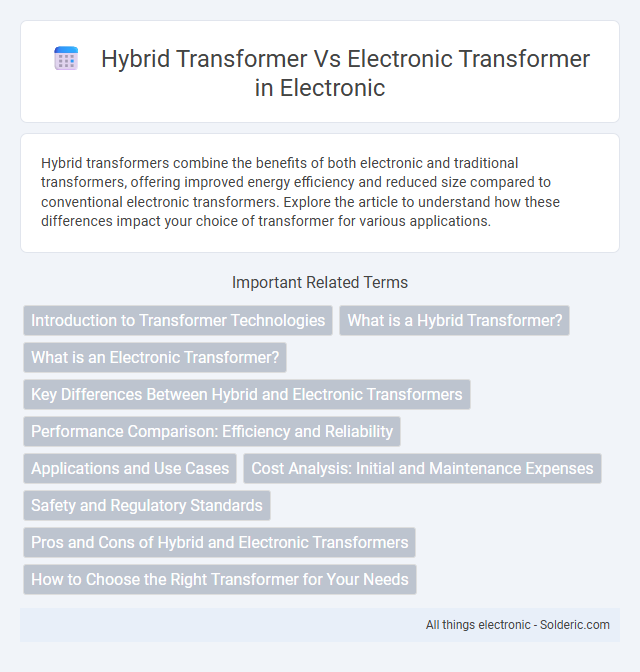Hybrid transformers combine the benefits of both electronic and traditional transformers, offering improved energy efficiency and reduced size compared to conventional electronic transformers. Explore the article to understand how these differences impact your choice of transformer for various applications.
Comparison Table
| Feature | Hybrid Transformer | Electronic Transformer |
|---|---|---|
| Working Principle | Combines magnetic core and electronic components to improve efficiency | Uses electronic circuits to convert voltage without magnetic cores |
| Efficiency | Higher efficiency due to reduced core losses and optimized electronics | Efficient in low power applications but varies by design |
| Size and Weight | More compact than traditional transformers but larger than electronic ones | Smaller and lighter owing to the absence of heavy iron cores |
| Energy Loss | Low energy loss with hybrid design | Low losses but can generate electromagnetic interference |
| Application | Suitable for power supplies requiring stability and efficiency | Common in low-voltage lighting and electronic devices |
| Cost | Generally higher due to complex design | Lower cost, mass-produced for consumer electronics |
| Reliability | Robust with longer lifespan | May have shorter life due to electronic component wear |
Introduction to Transformer Technologies
Transformer technologies encompass various types, including hybrid transformers and electronic transformers, each serving distinct applications. Hybrid transformers combine the advantages of magnetic and electronic components to enhance efficiency and reduce size in power conversion. Electronic transformers typically utilize semiconductor circuits for voltage regulation and offer improved precision and reliability in low-power applications.
What is a Hybrid Transformer?
A hybrid transformer combines the features of both electronic and traditional magnetic transformers to efficiently convert voltage with minimized energy losses and improved performance. Unlike purely electronic transformers, hybrid models offer enhanced durability, thermal management, and better compatibility with LED lighting systems. Understanding your options for hybrid transformers can help optimize energy consumption and extend the lifespan of your electrical devices.
What is an Electronic Transformer?
An electronic transformer is a compact, energy-efficient device designed to convert high-voltage AC mains electricity to a lower voltage suitable for low-voltage lighting systems, such as halogen lamps. Unlike traditional iron-core transformers, electronic transformers use high-frequency switching technology that allows for reduced size, weight, and improved performance. Your lighting system benefits from stable voltage output and reduced heat generation when using an electronic transformer compared to a hybrid transformer.
Key Differences Between Hybrid and Electronic Transformers
Hybrid transformers combine magnetic and electronic components, offering higher efficiency and reduced size compared to purely electronic transformers, which rely solely on semiconductor devices to regulate voltage. Electronic transformers provide precise voltage control and are ideal for low-power applications, while hybrid transformers excel in handling higher power loads with improved thermal management. Understanding these key differences helps you select the most suitable transformer for your specific electrical or lighting needs.
Performance Comparison: Efficiency and Reliability
Hybrid transformers generally offer higher efficiency by combining core materials optimized for reduced energy losses and improved thermal management, resulting in lower operational costs compared to traditional electronic transformers. Electronic transformers, while compact and suitable for low-voltage applications, often experience increased heat generation and limited reliability under fluctuating load conditions. The hybrid design's enhanced durability and consistent performance make it preferable for applications demanding long-term reliability and energy savings.
Applications and Use Cases
Hybrid transformers excel in electric vehicle charging stations and renewable energy systems due to their efficiency in managing variable loads and minimizing energy loss. Electronic transformers are commonly used in low-power applications such as LED lighting and small household appliances, offering compact design and precise voltage regulation. Your choice between these transformers depends on whether you require scalability and load adaptability or compactness and steady voltage output for specific electronic devices.
Cost Analysis: Initial and Maintenance Expenses
Hybrid transformers generally have higher initial costs due to advanced materials and improved efficiency, but their maintenance expenses are lower because of enhanced durability and fewer component replacements. Electronic transformers, while cheaper upfront, often incur higher maintenance costs over time due to susceptibility to wear and electronic component failures. Evaluating Your budget should consider both the initial investment and long-term maintenance to choose the most cost-effective transformer solution.
Safety and Regulatory Standards
Hybrid transformers offer enhanced safety features by integrating electronic components that provide better overload protection and reduce the risk of electrical fires compared to traditional electronic transformers. They comply with stringent regulatory standards such as IEC 61558 and UL 5085, ensuring reliable performance and adherence to safety requirements in various industrial and commercial applications. Choosing a hybrid transformer can improve Your system's overall safety while meeting international certification benchmarks.
Pros and Cons of Hybrid and Electronic Transformers
Hybrid transformers combine the advantages of both magnetic and electronic components, offering improved efficiency and reduced size compared to traditional electronic transformers. However, hybrid transformers can be more complex to manufacture and may have higher initial costs due to their integrated design. Electronic transformers are lightweight and cost-effective, but they might generate more electromagnetic interference and have lower durability under high load conditions.
How to Choose the Right Transformer for Your Needs
Choosing the right transformer depends on your specific application requirements and energy efficiency goals. Hybrid transformers combine the benefits of electronic and iron-core transformers, offering both compact size and minimal electromagnetic interference, which is ideal for sensitive electronic devices. Evaluate factors such as input voltage, output stability, load capacity, and thermal performance to ensure your selection matches your project's electrical and operational demands.
hybrid transformer vs electronic transformer Infographic

 solderic.com
solderic.com